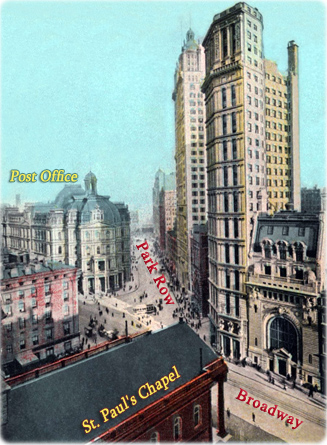
Park Row
Park Row is a street located in Manhattan. Its northern end is Chatham Square and its southern end is the intersection with Broadway, at Ann Street.
In the 17th century it was part of Bowery Lane, leading to the northern part of Manhattan Island. Before European intervention, it existed as a Lenape footpath.
In the early 18th century, it was part of the Post-Road to Boston, also called High Road to Boston (see James Lyne's Manuscript Plan, 1730). On June 27, 1774, the Common Council established that the street beginning at the house of Andrew Hopper (southeast corner of Broadway and Ann St.), nearly opposite St. Paul's Church, and leading to Fresh Water, be called Chatham Street (see Plan by Bernard Ratzer, 1767 and NYC map, 1866). Named after the Earl of Chatham, title created in 1766 for William Pitt the Elder (1708-1778).
The name Chatham Street was never popular, times were of conflicts for independence. The same happened with Great George Street, the name officially given to the street north of St. Paul's Chapel that officially became part of Broadway in 1794. In the first half of the 19th century, the section of Chatham Street bordering City Hall Park, was commonly called Chatham Row, Park Street or Park Row. It became officially Park Row in 1886.
After de demolition of the Brick Church at Beekman Street, in 1857, and the construction on the New York Times Building, completed in 1858 at 41 Park Row, the Printing House Square was formed.
In the second half of 19th century, Park Row and its surrounding area was home to several publishers, such as The World, Scientific American, Baker & Godwin, New York Times, Tribune, Sunday Times, New Yorker Staats-Zeitung, the New York Observer, Evening Mail, The Day Book / Weekly Day Book (1848–1879), Currier & Ives, Army & Navy Journal, The Albion, The Sun, The Sentinel and Freeman's Journal (in Tryon Row Buildings), American Tract Society and others. In the late 19th century, Park Row was also known as Newspaper Row. There were also other publishers around City Hall Park, such as The Technical Press, The New York Herald, the New-York Evening Post, the New York Evening Mail and others. In the late 19th century and early 20th century, many publishing industry headquarters moved to other parts of the City.
The old five-story Park Building, at 37 Park Row, was completed in 1857, sharing the site of the Old Brick Church with the NY Times Building. Later it became known as World Building (the old one). It housed some publishing industry headquarters, including The World, Scientific American and the New York Observer, founded in 1823. The building was burned down in 1882 and a new 11-story Potter Building was erected from 1883 to 1886, today a New York City landmark.
The old five-story Post Office building was constructed between 1869 and 1880, at the southern part of the Park. It was demolished in 1939.
In 1883, the Park Row Terminal, for the Brooklyn Bridge, was opened. It was later expanded and demolished in 1935.
Some of the early skyscrapers in New York City were built in Park Row or close to it, starting with the Tribune Building, which opened in 1875. In 1889, The NY Times Building was reconstructed to became a 13-story building. Then the World Building, completed in 1890, was the tallest building in New York City until 1894, when it was surpassed by the Manhattan Life Building. The American Tract Society skyscraper at 150 Nassau Street, adjacent to Printing House Square, was completed in 1895. In 1899, the 31-story Park Row Building (15 Park Row) was completed between Beekman and Ann streets. It was the tallest building in Manhattan at the end of the 19th century.
More: Park Row in 19th Century ►
The Municipal Building, at the intersection of Chambers Street and Centre Street, was completed in 1913.
In 1966, the Pace College complex was announced to be built on a two-block site across the City Hall Park, which included the site of the Tribune Building, that was demolished the same year, and the old NY Times Building at 41 Park Row. The 18-story Pace Plaza was erected between 1968 and 1970 for the Pace University. It is located at 1 Pace Plaza, 3 Spruce Street.


Old skyscrapers around City Hall Park, Park Row and Broadway in the 1990s.
Park Row
Park Row in the early 20th century, old postcard by Aristophoto Company.
By Jonildo Bacelar, Geographic Guide editor, September 2023.
|
Copyright © Geographic Guide - Old NYC. Historic Places. |
